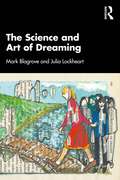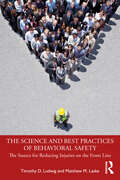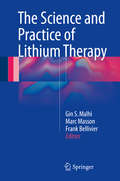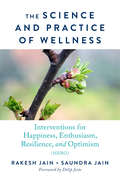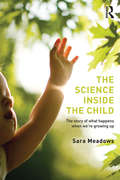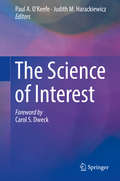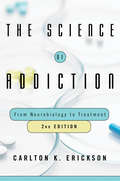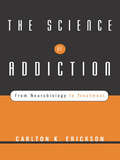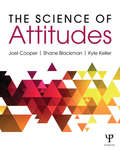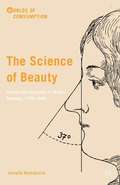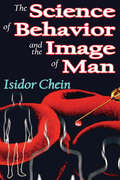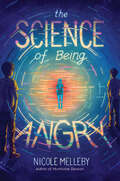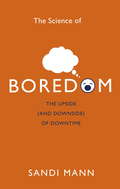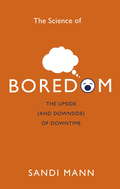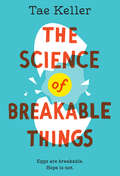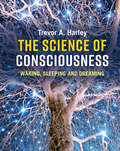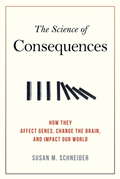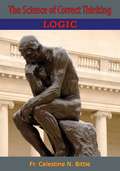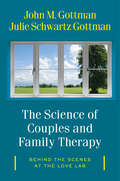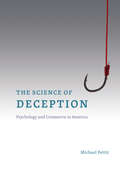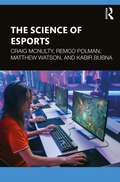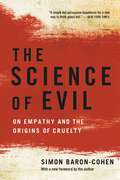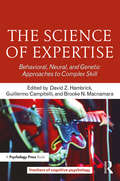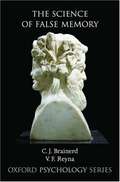- Table View
- List View
The Science and Art of Dreaming
by Mark Blagrove Julia LockheartThe Science and Art of Dreaming is an innovative text that reviews the neuroscience and psychology of how dreams are produced, how they are recalled and their relationship to waking life events and concerns of the dreamer. Featuring beautiful original artwork based on dream representations, the book delves deeply into what happens when we dream, the works of art we produce when asleep and the relevance of dreaming to science, art and film. The book examines the biological, psychological and social causes of dreaming, and includes recent advances in the study of nightmares and lucid dreaming. It shows how sleep can process memories and that dreams may reflect these processes, but also that dreams can elicit self-disclosure and empathy when they are shared after waking. The playfulness, originality and metaphorical content of dreams also link them to art, and especially to the cultural movement that has most valued dreams – Surrealism. The book details the history of scientific research into dreams, including a re-reading of the two dreams of Freud’s patient, the feminist hero Dora, and also the history of Surrealism and of films that draw on dreams and dream-like processes. Each chapter starts with a dream narrative and accompanying painting of the dream to highlight aspects of each of the chapter themes. This highly engaging book will be relevant to researchers, students and lecturers in the fields of psychology, neuroscience, psychoanalysis, consciousness and social evolution. It will also be of value within the study and practice of visual art, design and film, and will be of interest to the general reader and anyone who holds a personal interest in their own dreams.
The Science and Best Practices of Behavioral Safety: The Source for Reducing Injuries on the Front Line
by Timothy D. Ludwig Matthew M. LaskeThis book presents the scientific principles and real-world best practices of behavioral safety, one of the most mature and impactful applications of behavioral science to reduce injuries in industrial workplaces. The authors review the core principles of behavioral science and their application to modern safety processes. Process components are discussed in detail, including risk analysis and pinpointing, direct observation, performance feedback, reinforcing engagement, trending and functional analysis, behavior change interventions, and program evaluation. Discussions are complemented by industry best-practice case studies from world-class behavioral safety programs accredited by the Cambridge Center for Behavioral Studies (CCBS), which provide compelling evidence of the effectiveness of these behavioral science principles in reducing injury. The Science and Best Practices of Behavioral Safety is essential reading for safety professionals, process safety engineers, and leaders in companies who have implemented, or are considering implementing, behavioral safety; or as an aid to learning more about the scientific background behind effective and practical safety practices. Researchers, expert consultants, and students who are already familiar with the practice will also find the book a valuable source to further develop their expertise.
The Science and Fiction of Autism
by Laura SchreibmanAutism is a complex and incurable constellation of bizarre behaviors, impaired cognition, limited language, and most distressingly, a lack of responsiveness to other people, and it has been the center of impassioned debates for decades. What is it? What causes it? How can it be treated? In The Science and Fiction of Autism, one of the country's leading experts in behavioral treatments approaches autism through the context of its controversies, showing where extraordinary and unfounded claims have falsely raised hopes, stirred fears, and ruined lives. Arguing that autism is an entirely biological disorder, however complex its neurological origins, Laura Schreibman lays waste to the beliefs that it is caused by "refrigerator mothers" or the MMR vaccine, as well as to the simplistic claims that it can be cured by a variety of unsubstantiated treatments. Drawing from her own long clinical experience with autistic children and their parents, Schreibman arms her readers--students, educators, psychologists, and parents alike--with information and arguments to deal with the onslaught of good, bad, deficient, and irrelevant ideas about autism.
The Science and Practice of Lithium Therapy
by Frank Bellivier Gin S. Malhi Marc MassonThis book provides a clear and comprehensive guide to the clinical prescription of lithium that draws upon evidence-based knowledge of its mechanisms of action. The book is divided into two parts, on the science of lithium and the practice of lithium therapy. The former covers aspects such as the properties of the lithium ion, pharmacokinetics and pharmacodynamics, impact on neurotransmission, and gene expression modulation. The section on practice includes discussion of variability in response to lithium, use of lithium in the treatment of bipolar disorders, its value in suicide prevention, administration during pregnancy and in the pediatric age group, and side effects. Lithium is arguably the only true mood stabilizer, and its multifaceted effects across many clinical domains have given rise to a resurgence of interest in recent years, fuelled by both researchers and clinicians. Nevertheless, its use remains constrained by exaggerated concerns about potential side-effects. In reality, lithium is a simple molecule that is relatively straightforward to administer and monitor and has potentially profound benefits at a fraction of the cost of contemporary agents. This book dispels the many myths and concerns that surround its use and will be of interest for clinicians and researchers worldwide, and those that are recipients of lithium therapy.
The Science and Practice of Wellness (HERO): Interventions For Happiness, Enthusiasm, Resilience, And Optimism (hero)
by Rakesh Jain Saundra JainA dynamic approach to mental health and wellness, ready for any clinician to implement. Wellness is rapidly becoming an issue of great importance in clinical practice. Wellness-centric clinicians look to improve various traits known to be beneficial to patients— traits such as happiness, enthusiasm, resilience, and optimism (referred to as the HERO traits). All of these not only improve global mental wellness, but also offer resilience against stress, depression, and anxiety. Wellness-centric interventions augment both psychopharmacology and traditional psychotherapies, such as CBT. Rakesh and Saundra Jain start with an in- depth review of the scientific literature and a practical introduction on applying wellness interventions in various clinical settings. Additionally, they offer advice on such beneficial practices as exercise, mindfulness, optimized nutrition, optimized sleep, enhanced socialization, and positive psychology enhancement. A robust resource section offers access to wellness-centric scales and forms developed by the authors.
The Science inside the Child: The story of what happens when we're growing up
by Sara MeadowsThis engaging book presents some of the ways in which science can describe and explain how and why children develop in the way they do. It looks at children’s individual development within the development of our species, at genes, at the hormone systems that flood our bodies, at the neuroscience of children’s brains, and at patterns of behaviour. It looks, in other words, at the different influences on child development according to the scientific disciplines of evolutionary theory, genetics, epigenetics, endocrinology, neuroscience, epidemiology and psychology. Filled with entertaining anecdotes, Sara Meadows shares the story of what happens when we’re growing up, revealing how science can add depth to our understanding. This book will be an informative and enriching read for all parents, educators and carers, and those interested in how children develop to be emotionally balanced, socially skilled, and enthusiastic seekers after knowledge.
The Science of Interest
by Paul A. O'Keefe Judith M. HarackiewiczThis exceptional volume analyzes the intricate roles interest plays in cognition, motivation and learning, and daily living, with a special focus on its development and maintenance across life domains. Leading experts discuss a spectrum of interest ranging from curiosity to obsession, and trace its functions in goal-setting, decision-making, self-regulation, and performance. New research refines the current knowledge on student interest in educational settings and the social contexts of interest, with insights into why interest levels change during engagement and in the long run. From these findings, contributors address ways to foster and nurture interest in the therapy room and the classroom, for optimum benefits throughout life. Among the topics covered: #65533; Embedding interest within self-regulation. #65533; Knowledge acquisition at the intersection of situational and individual interest. #65533; The role of interest in motivation and engagement. #65533; The two faces of passion. #65533; Creative geniuses, polymaths, child prodigies, and autistic savants. #65533; The promotion and development of interest. A robust guide to a fascinating area of study, The Science of Interest synthesizes the field's current knowledge of interest and indicates future directions. Its chapters contribute depth and rigor to this growing area of research, and will enhance the work of researchers in education, psychologists, social scientists, and public policymakers.
The Science of Addiction: From Neurobiology To Treatment
by Carlton K. EricksonAn updated and expanded edition on the roles that brain function and genetics play in addiction. Over the past 10 years, neurobiologic and genetic research has provided an increased understanding of what causes drug addiction in the brain’s reward pathway. Knowing this leads to a better understanding of how it may be treated and even reversed in those who successfully overcome the disease. This is especially true with addiction’s possible precursors of mild to moderate substance use disorders. These latter disorders can usually be treated more easily by less intensive models of “treatment” that do not require actual brain chemistry re-regulation over time. In this new edition, there are updated scientific references to support addiction as a medical brain disease, using the prevailing neurobiology, genetics, and psychological scientific literature. We now have more psychosocial and medicinal methods for reversing abnormal brain chemistry during drug addiction. There are also more effective intervention, counseling, and motivating methods (SBIRT, motivational interviewing) for overcoming resistance to treatment and resistance to change than were able to be discussed when the first edition was published over a decade ago. Here, readers will find a fully-updated glossary of terms, additional abbreviations, and updated appendices. These will aid in clarifying the somewhat lengthy and science-based upgrades in our knowledge of neuroscience and genetics research that are so critical in understanding why addiction is such a serious and tough-to-treat disease. Utilizing the same easy-to-read language that was a hallmark of the earlier edition, Erickson keeps the science understandable yet comprehensive—appropriate for health professionals as well as lay readers who need and want this critical information.
The Science of Addiction: From Neurobiology to Treatment
by Carlton K. EricksonA comprehensive overview of the neurobiology behind addictions. Neuroscience is clarifying the causes of compulsive alcohol and drug use--while also shedding light on what addiction is, what it is not, and how it can best be treated--in exciting and innovative ways. Current neurobiological research complements and enhances the approaches to addiction traditionally taken in social work and psychology. However, this important research is generally not presented in a forthright, jargon-free way that clearly illustrates its relevance to addiction professionals. The Science of Addiction presents a comprehensive overview of the roles that brain function and genetics play in addiction. It explains in an easy-to-understand way changes in the terminology and characterization of addiction that are emerging based upon new neurobiological research. The author goes on to describe the neuroanatomy and function of brain reward sites, and the genetics of alcohol and other drug dependence. Chapters on the basic pharmacology of stimulants and depressants, alcohol, and other drugs illustrate the specific and unique ways in which the brain and the central nervous system interact with, and are affected by, each of these substances Erickson discusses current and emerging treatments for chemical dependence, and how neuroscience helps us understand the way they work. The intent is to encourage an understanding of the body-mind connection. The busy clinical practitioner will find the chapter on how to read and interpret new research findings on the neurobiological basis of addiction useful and illuminating. This book will help the almost 21.6 million Americans, and millions more worldwide, who abuse or are dependent on drugs by teaching their caregivers (or them) about the latest addiction science research. It is also intended to help addiction professionals understand the foundations and applications of neuroscience, so that they will be able to better empathize with their patients and apply the science to principles of treatment.
The Science of Attitudes
by Joel Cooper Kyle Keller Shane BlackmanThe Science of Attitudes is the first book to integrate classic and modern research in the field of attitudes at a scholarly level. Designed primarily for advanced undergraduates and graduate students, the presentation of research will also be useful for current scholars in all disciplines who are interested in how attitudes are formed and changed. The treatment of attitudes is both thorough and unique, taking a historical approach while simultaneously highlighting contemporary views and controversies. The book traces attitudes research from the inception of scientific study following World War II to the issues and methods of research that are prominent features of today's research. Researchers in the field of attitudes will be particularly interested in classic and modern research on the organization, structure, strength and function of attitudes. Researchers in the field of persuasion will be particularly interested in work on attitude change focusing on propositional and associative learning, metacognition and dynamic theories of dissonance, balance and reactance. The book is designed to present the integration of the properties of the attitude with the dynamic considerations of attitude change. The Science of Attitudes is also the first book on attitudes to devote entire chapters to work on implicit measurements, resistance to persuasion, and social neuroscience.
The Science of Beauty
by Annelie RamsbrockWhat did the cosmetics practices of middle-class women in the nineteenth century have in common with the repair of men's bodies mutilated in war? What did the New Woman of the Weimar years have to do with the field of social medicine that emerged in the same period? They were all part of a conversation about the cosmetic modification of bodies, a debate shaped by scientific knowledge and normative social models. Conceived as a cultural history, this book examines the history of artificially created beauty in Germany from the late Enlightenment to the early days of National Socialist rule.
The Science of Behavior and the Image of Man
by Carl von ClausewitzDoes a proper respect for science require psychologists to view man as an impotent reactor whose responses are completely determined by his physical constitution and the forces impinging upon him? In this wise and well-argued book, Isidor Chein invites his readers to lift their eyes from experimental research for a time to consider the relationship between science and the image of man.Few psychologists, even the most gifted and dedicated among them, pause to consider the philosophical underpinnings of their work. It is almost as though the humanist secretly lurking in each of them is fearful of the bad news he might finally be forced to accept--that man is essentially an exquisitely complicated robot. This fear is misplaced and harmful. It is largely responsible for the disturbing fact that scientific psychology has produced, in Chein's estimate, so little that is relevant to the humanities, so little, as he puts it, "that has lived up to psychology's promise to itself."What must be more widely understood is that it does not follow that behavioral law is reducible to physiological law, or that physiological law is reducible to physical law. With an uncompromising commitment to scientific method, Chein shows that, when closely analyzed, there is actually no need to assume an unbridgeable gap between scientific psychology and psychoanalytic, humanistic psychology. This is a lucid and powerful theoretical work of importance for scholars in all fields sharing the belief that the proper study of mankind is man."The Science of Behavior and the Image of Man is written by the most intellectually stimulating and respected representative of scientific humanistic psychology."--Robert B. Holt, Professor of Psychology, Graduate School of Arts and Sciences, New York University
The Science of Being Angry
by Nicole MellebyFrom the acclaimed author of Hurricane Season, an unforgettable story about what makes a family, for fans of Hazel&’s Theory of Evolution and Ivy Aberdeen&’s Letter to the World. Eleven-year-old Joey is angry. All the time. And she doesn&’t understand why. She has two loving moms, a supportive older half brother, and, as a triplet, she&’s never without company. Her life is good. But sometimes she loses her temper and lashes out, like the time she threw a soccer ball—hard—at a boy in gym class and bruised his collarbone. Or when jealousy made her push her (former) best friend (and crush), Layla, a little bit too roughly. After a meltdown at Joey&’s apartment building leads to her family&’s eviction, Joey is desperate to figure out why she&’s so mad. A new unit in science class makes her wonder if the reason is genetics. Does she lose control because of something she inherited from the donor her mothers chose?The Science of Being Angry is a heartwarming story about what makes a family and what makes us who we are.
The Science of Boredom: The Upside (and Downside) of Downtime
by Sandi MannAre we living in an age where we are more boredom-prone? Or are other people boring us? Or could we be that boring person?! In our current information age, we are constantly connected to technology, and have so many varied ways to spend our leisure time that we should all surely never know what boredom feels like. Yet, boredom appears to be on the rise; it seems that the more we have to stimulate us, the more stimulation we crave. In a quest to relieve our boredom, we engage in dangerous risk-taking - from extreme sports to drugs to gambling to anti-social behaviour, or we overindulge in shopping or eating. The Science of Boredom explores the causes and consequences of boredom in the fast-paced twenty-first century. Parents are desperate to keep their children entertained during every waking moment, the education system is geared towards interactivity, and attention spans are dropping as we use multiple devices at all times. But the world of work can be increasingly repetitive and routine, and we are losing the ability to tolerate this everyday tedium. Using Sandi Mann's own ground-breaking research into boredom, this book tells the story of how we act, react and cope when we are bored, and argues that there is a positive side to boredom. It can be a catalyst for humour, fun, reflection, creativity and inspiration. The radical solution to the 'boredom problem' is to harness it rather than try to avoid it. Allowing yourself time away from constant stimuli can enrich your life. We should all embrace our boredom and see the upside of our downtime.
The Science of Boredom: Why Boredom is Good
by Dr Sandi MannAre we living in an age where we are more boredom-prone? Or are other people boring us? Or could we be that boring person?! In our current information age, we are constantly connected to technology, and have so many varied ways to spend our leisure time that we should all surely never know what boredom feels like. Yet, boredom appears to be on the rise; it seems that the more we have to stimulate us, the more stimulation we crave. In a quest to relieve our boredom, we engage in dangerous risk-taking - from extreme sports to drugs to gambling to anti-social behaviour, or we overindulge in shopping or eating. The Science of Boredom explores the causes and consequences of boredom in the fast-paced twenty-first century. Parents are desperate to keep their children entertained during every waking moment, the education system is geared towards interactivity, and attention spans are dropping as we use multiple devices at all times. But the world of work can be increasingly repetitive and routine, and we are losing the ability to tolerate this everyday tedium. Using Sandi Mann's own ground-breaking research into boredom, this book tells the story of how we act, react and cope when we are bored, and argues that there is a positive side to boredom. It can be a catalyst for humour, fun, reflection, creativity and inspiration. The radical solution to the 'boredom problem' is to harness it rather than try to avoid it. Allowing yourself time away from constant stimuli can enrich your life. We should all embrace our boredom and see the upside of our downtime.
The Science of Breakable Things
by Tae KellerAn emotionally-charged new classic about the science of hope, love, and miracles! Natalie's uplifting story of using the scientific process to "save" her mother from depression is sure to take root in readers' hearts!How do you grow a miracle? For the record, this is not the question Mr. Neely is looking for when he says everyone in class must answer an important question using the scientific process. But Natalie's botanist mother is suffering from depression, so this is The Question that's important to Natalie. When Mr. Neely suggests that she enter an egg drop competition, Natalie has hope. Eggs are breakable. Hope is not.Natalie has a secret plan for the prize money. She's going to fly her mother to see the Cobalt Blue Orchids--flowers that survive against impossible odds. The magical flowers are sure to inspire her mother to love life again. As Natalie prepares for the competition, she will discover that talking about problems is like taking a plant out of a dark cupboard and giving it light.An extraordinary debut about the coming-of-age moment when kids realize that parents are people, too. Think THE FOURTEENTH GOLDFISH meets THE THING ABOUT JELLYFISH."A compassionate glimpse of mental illness accessible to a broad audience." --Kirkus Reviews, STARRED REVIEW"Keller crafts a winning story full of heart and action." --Booklist, STARRED REVIEW"Inspiring, emotional, and heartwarming."--Melissa Savage, author of Lemons
The Science of Consciousness: Waking, Sleeping and Dreaming
by Trevor A. HarleyConsciousness concerns awareness and how we experience the world. How does awareness, a feature of the mental world, arise from the physical brain? Is a dog conscious, or a jellyfish, and what explains the difference? How is consciousness related to psychological processes such as perception and cognition? The Science of Consciousness covers the psychology, philosophy, and neuroscience of consciousness. Written for introductory courses in psychology and philosophy, this text examines consciousness with a special emphasis on current neuroscience research as well as comparisons of normal and damaged brains. The full range of normal and altered states of consciousness, including sleep and dreams, hypnotic and meditative states, anesthesia, and drug-induced states, as well as parapsychological phenomena and their importance for the science of consciousness is covered, as well as the 'higher' states and how we can attain them. Throughout the text attempts to relate consciousness to the brain.
The Science of Consequences
by Susan M. SchneiderFeaturing illustrative human, pet, and wild-animal anecdotes, this book is a unique and fascinating introduction to a science that is truly epic in scope. Children quickly learn that actions have consequences. This elementary lesson is repeated again and again throughout adulthood as we adjust our behaviors according to the reactions they produce in the social and natural environment. Now, an internationally recognized biopsychologist, tells the story of how something so deceptively simple can help make sense of so much. Despite their variety, consequences appear to follow a common set of scientific principles and share some similar effects in the brain (specifically, in the so-called pleasure centers). Based on these principles, Schneider and other scientists have been able to create mathematical models of certain behaviors. And they have demonstrated that learning from consequences predictably activates genes and restructures the neural configuration of the brain-in humans as well as in animals. Consequences are an integral part of the nature-and-nurture system. The knowledge gained from this newly expanded science has many applications, as the author shows in examples from the home, the hospital, the classroom, and the boardroom. The science of consequences helps fight prejudice, free addicts of their destructive habits, and treat depression. It enriches the lives of pets and zoo animals. It also sheds light on our biggest societal challenges, where we must choose between short-term and long-term consequences.
The Science of Correct Thinking: Logic
by Fr. Celestine N. BittleFirst published in 1935, the author of this book has attempted to treat the most fundamental department of philosophy—logic—by combining the advantages of both textbooks and monographs, and by avoiding undue complication and technicality. Through the use of simple language and numerous illustrations, Fr. Bittle endeavoured to render the subject understandable, and as such this book is intended as a textbook or as supplementary reading in classwork, or as an introduction to philosophy for the general reader.“Philosophy cannot be made easy, but it certainly can be made less difficult. At the same time, the technical side of logic has not been omitted, but has been built up in gradual stages, so that the mind of the student can grow with the subject.”—Fr. Celestine N. Bittle
The Science of Couples and Family Therapy: Behind the Scenes at the "Love Lab"
by John M. Gottman Julie Schwartz GottmanBringing an evidence base to classic writings that opened psychotherapy up to more than one person at a time—the couple. John and Julie Gottman, world-renowned for bringing an evidence base to couples therapy, report here the results of a second empirical revolution in understanding couples and families. This change is not based on their guesswork, but on state-of-the-art science. The book you hold in your hands finally completes the old general systems theory of the 1960s, which metaphorically described processes but did not actually research them. A new general systems theory and therapy is presented here, one which will have profound implications for powerful clinical work with both couples and families. This new theory is based on 45 years of careful basic scientific research with thousands of couples and families, including synchronized observational, interview, physiological, and questionnaire data. The Gottmans have studied some families for as long as 20 consecutive years. Their work has led to their highly replicated ability to precisely predict the future of relationships, relationship happiness, and whether couples will divorce or not with as much as 94% accuracy. Their empirical work has also led them to develop and test a theory of specifically what makes relationships work. Each construct in this theory is precise and measurable and it is all written about and described here. This book presents an original new way of understanding relationships and families. Both theoretical and highly practical, and it will help clinicians become more effective in their everyday work.
The Science of Deception: Psychology and Commerce in America
by Michael PettitDuring the late nineteenth and early twentieth centuries, Americans were fascinated with fraud. P. T. Barnum artfully exploited the American yen for deception, and even Mark Twain championed it, arguing that lying was virtuous insofar as it provided the glue for all interpersonal intercourse. But deception was not used solely to delight, and many fell prey to the schemes of con men and the wiles of spirit mediums. As a result, a number of experimental psychologists set themselves the task of identifying and eliminating the illusions engendered by modern, commercial life. By the 1920s, however, many of these same psychologists had come to depend on deliberate misdirection and deceitful stimuli to support their own experiments. "a""The Science of Deception "explores this paradox, weaving together the story of deception in American commercial culture with its growing use in the discipline of psychology. Michael Pettit reveals how deception came to be something that psychologists not only studied but also employed to establish their authority. They developed a host of toolsOCothe lie detector, psychotherapy, an array of personality tests, and moreOCofor making deception more transparent in the courts and elsewhere. PettitOCOs study illuminates the intimate connections between the scientific discipline and the marketplace during a crucial period in the development of market culture. With its broad research and engaging tales of treachery, "The Science of Deception "will appeal to scholars and general readers alike.
The Science of Esports
by Matthew Watson Craig McNulty Remco Polman Kabir BubnaThe Science of Esports draws from contemporary research and coach expertise to examine esports athlete health and performance from a range of disciplinary perspectives, including physiology, psychology, sociology, and nutrition. The rapid expansion of the esports industry has elevated competitive video gaming into the realm of high performance, requiring players, coaches, and practitioners to implement interdisciplinary approaches to performance support. The book covers key topic areas such as: What esports is and similarities and differences to sport Game-specific training Physiological and psychological consideration for esports athletes Social aspects of player performance and the social environment of esports Esports coaching and structure of esports performance environments Technology and its use in esports Safeguarding, cheating, and gambling This book includes worked examples and case studies to allow immediate implementation into practice for esports athletes and coaches. It summarises the current state of research to inform researchers and identify gaps in knowledge. This book is critical reading for students of esports and related courses. It serves as the first scientific resource designed to provide athletes, coaches, and practitioners with interdisciplinary insights into esports health and performance.
The Science of Evil: On Empathy and the Origins of Cruelty
by Simon Baron-CohenBorderline personality disorder, autism, narcissism, psychosis, Asperger's: All of these syndromes have one thing in common--lack of empathy. In some cases, this absence can be dangerous, but in others it can simply mean a different way of seeing the world. In The Science of Evil Simon Baron-Cohen, an award-winning British researcher who has investigated psychology and autism for decades, develops a new brain-based theory of human cruelty. A true psychologist, however, he examines social and environmental factors that can erode empathy, including neglect and abuse. Based largely on Baron-Cohen's own research, The Science of Evil will change the way we understand and treat human cruelty.
The Science of Expertise: Behavioral, Neural, and Genetic Approaches to Complex Skill (Frontiers of Cognitive Psychology)
by David Z. Hambrick Guillermo Campitelli Brooke N. MacnamaraOffering the broadest review of psychological perspectives on human expertise to date, this volume covers behavioral, computational, neural, and genetic approaches to understanding complex skill. The chapters show how performance in music, the arts, sports, games, medicine, and other domains reflects basic traits such as personality and intelligence, as well as knowledge and skills acquired through training. In doing so, this book moves the field of expertise beyond the duality of "nature vs. nurture" toward an integrative understanding of complex skill. This book is an invaluable resource for researchers and students interested in expertise, and for professionals seeking current reviews of psychological research on expertise.
The Science of False Memory (Oxford Psychology Series #38)
by V. F. Reyna C. J. BrainerdFindings from research on false memory have major implications for a number of fields central to human welfare, such as medicine and law. Although many important conclusions have been reached after a decade or so of intensive research, the majority of them are not well known outside the immediate field. To make this research accessible to a much wider audience, The Science of False Memory has been written to require little or no background knowledge of the theory and techniques used in memory research.
